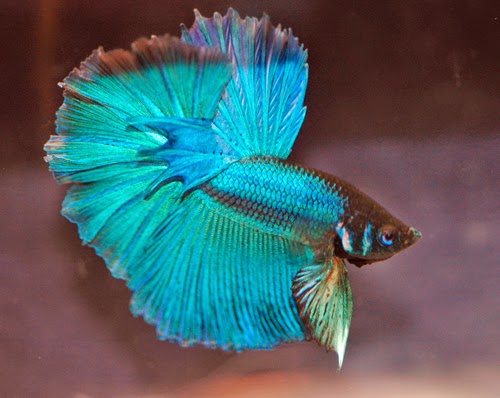As a betta owner and breeder, I've worked with and witnessed many distinct and gorgeous varieties of color in individual bettas. The following are the most popular and desirable color types for bettas.
Black, or melano, bettas are an uncommon color variety, because they are notoriously difficult to breed. Their color ranges from a deep onyx color to a smokey black, and they may resemble livebeare black mollies at first glance. Most black female bettas are sterile, so creating consistent strains can be nearly impossible, even for the most accomplished breeders.
White
Bettas, like most fish species, sometimes have albino individuals that appear in otherwise colored gene pools. Albino bettas have pink or red eyes and completely transparent fins, and are extremely rare. The non-albino white betta is slightly more common, and has a pearlescent body with black eyes.
Red
Red bettas are very common, and one of the most widely seen varieties in pet stores and home aquaria because they are easy to breed. Some red bettas have a sheen of blue, white, or brown, which pulls away from the total, deep vermillion color seen as desirable by breeders.
Violet
True violet bettas are rare, but bettas may appear violet in color if they are red with a blue sheen, or blue with a red sheen. Although some amateur aquarists like the look of opaque sheens that create alternating color effects, most breeders frown upon these strains because they tend to cross-pollute gene pools with undesirable traits and unpredictable fry.
Royal Blue
Another very common variety, royal blue bettas are easy to breed and usually a cornflower-type color. Ideally, they have no sheen of red, green, or any other opaque color, but most inexpensive bettas of this variety have other traits.
Steel blue, or metallic blue, bettas are identical to royal blue bettas, but with a light metallic or whitish sheen. Some of them appear to be greenish or grayish in color. There is conflict within the betta breeding community about whether or not metallic blue is a desirable trait.
Turquouise
Difficult to breed, the turqouise betta is a rare beauty when it is consistently colored throughout. However, most turqouise bettas have flecks of black, blue, white, green, or any other sheen color. They most often have green base tones with pale blue sheens.
True forest-green bettas with no sheens or undertones are the Holy Grail of betta breeding, because they are nearly impossible to acheive. The genes involved in breeding green bettas are complex and not fully understood, so they vary widely across generations. Most green bettas have blue-gray, blue-green, or blackish sheens, but many breeders work to eliminate this.
Yellow
Pastel-yellow bettas are a variation of the red gene, so many yellow bettas have red undertones or markings. Many yellow strains are polluted with brown tints or overly pale shades, but some breeders have successfully created strains of butter-yellow and gold betta.
Peach
Peach bettas are usually the result of pale-yellow bettas with red-orange sheens. These varieties are difficut to breed across generations and sometimes dubbed "pineapple" bettas or "apricot" bettas. The apricot coloration is strongest on the betta's fins.
Chocolate
Actual brown bettas are rare, and some breeders even say that they are nonexistant. However, bettas may appear chocolate in color if they have tightly-checkered yellow and brown fins. Some breeders strengthen chocolate gene pools by breeding chocolate bettas with black or yellow mates.
Betta breeding a thrilling, addictive hobby that acts as a constant reminder of the beauty and splendor of Mother Nature's own fantastic breeding programs. Constant advances in the exciting field of betta breeding constantly yield new varieties of color within the species.











No comments:
Post a Comment